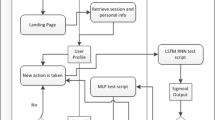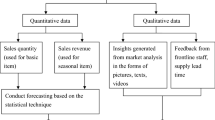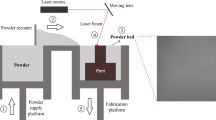Abstract
The purposes are to improve the accuracy of inventory demand forecast, balance the indexes of enterprises, and reduce the costs of human, material and financial resources of enterprises and suppliers, thus reducing the supply chain costs and meeting the actual needs of enterprises. In terms of training a large amount of data, deep learning is better than traditional machine learning. The sales demand time series data and the previous material demand time series data are input and trained by back propagation (BP) neural network, and then the material demand value is output. Therefore, the historical data of sales demand forecast and material information are input, and the model is established by BP neural network, which not only takes into account the decisive factor of sales demand forecast, but also considers the material consumption, achieving more accurate forecast. The material demand budget of enterprises is analyzed and a material forecast demand model based on deep learning algorithm is proposed. The model uses a neural network to input the sales demand forecast data, material inventory information and material attribute information into the model, and then the model is trained by the training set in accordance with the error back propagation algorithm. Finally, the training effect of the model is tested by the test set. The results show that when the independent variables include sales demand forecast, material consumption forecast and material attribute information, the forecast error of both models is lower and the effect is better, compared with the material consumption data only as an independent variable. The forecast method based on neural network proposed increases the lead time of the forecast, give the supplier a longer time to prepare goods, and reduce the shortage or surplus of supply caused by the short lead time. Therefore, the material demand forecast model based on convolution neural network (CNN) algorithm provides an important reference for the enterprises, helps them improve their work efficiency and promotes the development of enterprises. This model achieves a great improvement on the accuracy of material demand forecast, and has a certain guiding significance in relevant theory and practice.









Similar content being viewed by others
References
Al-Musaylh MS, Deo RC, Adamowski JF et al (2018) Short-term electricity demand forecasting with MARS, SVR and ARIMA models using aggregated demand data in Queensland, Australia. Adv Eng Inform 35:1–16
Allwood JM, Gutowski TG, Serrenho AC et al (2017) Industry 1.61803: the transition to an industry with reduced material demand fit for a low carbon future. R Soc Publ 4(14):224–236
Bakhtavar E, Hosseini S, Hewage K et al (2021) Green blasting policy: simultaneous forecast of vertical and horizontal distribution of dust emissions using artificial causality-weighted neural network. J Clean Prod 283:124562–124573
Bedi J, Toshniwal D (2018) Empirical mode decomposition based deep learning for electricity demand forecasting. IEEE Access 6:49144–49156
Behera R, Pati BB, Panigrahi BP (2014) A long term load forecasting of an indian grid for power system planning. J Inst Eng India Ser B 95(4):279–285
Campos GS, Rocha N, Gondim AR (2020) Smart & green: an internet-of-things framework for smart irrigation. Sensors 20(1):190–196
Deepika N, Bhat MN (2021) An efficient stock market prediction method based on Kalman filter. J Inst Eng India Ser B 109:1–16
Fu W, Chien C-F (2019) UNISON data-driven intermittent demand forecast framework to empower supply chain resilience and an empirical study in electronics distribution. Comput Ind Eng 135:940–949
Gangrade J, Bharti J (2020) Vision-based hand gesture recognition for Indian sign language using convolution neural network. IETE J Res 120:1–10
Gavidia JV (2017) A model for enterprise resource planning in emergency humanitarian logistics. J Humanit Logist Supply Chain Manag 7(3):429–432
Graser J, Kauwe SK, Sparks TD (2018) Machine learning and energy minimization approaches for crystal structure predictions: a review and new horizons. Chem Mater 30(11):3601–3612
Huber J, Gossmann A, Stuckenschmidt H (2017) Cluster-based hierarchical demand forecasting for perishable goods. Expert Syst Appl 76:140–151
Kucukvar M, Onat NC, Haider MA (2018) Material dependence of national energy development plans: the case for Turkey and United Kingdom. J Clean Prod 200:490–500
Pechmann A, Zarte M (2017) Procedure for generating a basis for PPC systems to schedule the production considering energy demand and available renewable energy. Procedia CIRP 64:393–398
Poggi F, Firmino A, Amado M (2017) SMART RURAL: A model for planning net-zero energy balance at municipal level. Energy Procedia 122:56–61
Pohludka M, Stverkova H, Ślusarczyk B (2018) Implementation and unification of the ERP system in a global company as a strategic decision for sustainable entrepreneurship. Sustainability 10(8):2916–2922
Priyadarsini K, Mishra N, Prasad M et al (2021) Detection of malware on the internet of things and its applications depends on long short-term memory network. J Ambient Intell Humaniz Comput 112:1–12
Shen C, Wang C, Wei X et al (2019) Physical metallurgy-guided machine learning and artificial intelligent design of ultrahigh-strength stainless steel. Acta Mater 179:201–214
Sun W, Zheng Y, Yang K et al (2019) Machine learning-assisted molecular design and efficiency prediction for high-performance organic photovoltaic materials. Sci Adv 5(11):4275–4286
Suresha HS, Parthasarathy SS (2021) Probabilistic principal component analysis and long short-term memory classifier for automatic detection of Alzheimer’s disease using MRI brain images. J Inst Eng India Ser B 31:1–12
Wang P, Gao RX, Yan R (2017) A deep learning-based approach to material removal rate prediction in polishing. CIRP Ann 66(1):429–432
Wang K, Zhuo L, Li J et al (2020) Learning an enhancement convolutional neural network for multi-degraded images. Sens Imaging 21:1–15
Wang C, Jin Y, Chen X et al (2020) Automatic classification of volumetric optical coherence tomography images via recurrent neural network. Sens Imaging 21(1):1–15
Yamashita R, Nishio M, Do RKG et al (2018) Convolutional neural networks: an overview and application in radiology. Insights Into imaging 9(4):611–629
Yao P, Wu H, Gao B et al (2020) Fully hardware-implemented memristor convolutional neural network. Nature 577(7792):641–646
Zhao M, Peng Y (2021) A multi-module medical image fusion method based on non-subsampled shear wave transformation and convolutional neural network. Sens Imaging 22(1):1–16
Acknowledgments
The authors acknowledge the help from the university teachers.
Funding
This research received no external funding.
Author information
Authors and Affiliations
Contributions
All authors listed have made a substantial, direct and intellectual contribution to the work, and approved it for publication.
Corresponding author
Ethics declarations
Conflict of Interest
All authors declare that they have no conflict of interest.
Ethical approval
This article does not contain any studies with human participants or animals performed by any of the authors.
Informed consent
Informed consent was obtained from all individual participants included in the study.
Additional information
Publisher’s Note
Springer Nature remains neutral with regard to jurisdictional claims in published maps and institutional affiliations.
Rights and permissions
About this article
Cite this article
Tang, Z., Ge, Y. CNN model optimization and intelligent balance model for material demand forecast. Int J Syst Assur Eng Manag 13 (Suppl 3), 978–986 (2022). https://doi.org/10.1007/s13198-021-01157-0
Received:
Revised:
Accepted:
Published:
Issue Date:
DOI: https://doi.org/10.1007/s13198-021-01157-0




